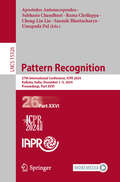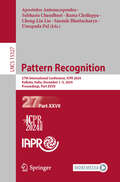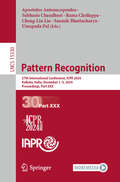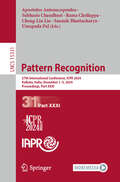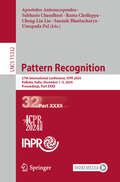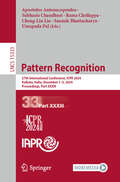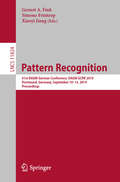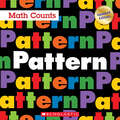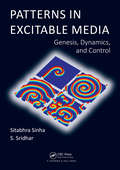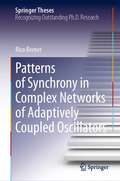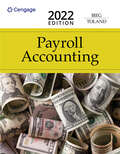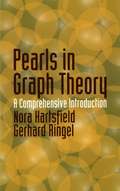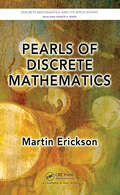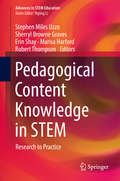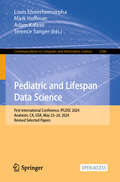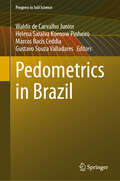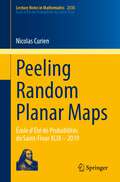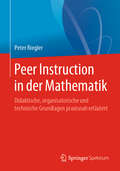- Table View
- List View
Pattern Recognition: 27th International Conference, ICPR 2024, Kolkata, India, December 1–5, 2024, Proceedings, Part XXVI (Lecture Notes in Computer Science #15326)
by Rama Chellappa Subhasis Chaudhuri Cheng-Lin Liu Umapada Pal Apostolos Antonacopoulos Saumik BhattacharyaThe multi-volume set of LNCS books with volume numbers 15301-15333 constitutes the refereed proceedings of the 27th International Conference on Pattern Recognition, ICPR 2024, held in Kolkata, India, during December 1–5, 2024. The 963 papers presented in these proceedings were carefully reviewed and selected from a total of 2106 submissions. They deal with topics such as Pattern Recognition; Artificial Intelligence; Machine Learning; Computer Vision; Robot Vision; Machine Vision; Image Processing; Speech Processing; Signal Processing; Video Processing; Biometrics; Human-Computer Interaction (HCI); Document Analysis; Document Recognition; Biomedical Imaging; Bioinformatics.
Pattern Recognition: 27th International Conference, ICPR 2024, Kolkata, India, December 1–5, 2024, Proceedings, Part XXVII (Lecture Notes in Computer Science #15327)
by Rama Chellappa Subhasis Chaudhuri Cheng-Lin Liu Umapada Pal Apostolos Antonacopoulos Saumik BhattacharyaThe multi-volume set of LNCS books with volume numbers 15301-15333 constitutes the refereed proceedings of the 27th International Conference on Pattern Recognition, ICPR 2024, held in Kolkata, India, during December 1–5, 2024. The 963 papers presented in these proceedings were carefully reviewed and selected from a total of 2106 submissions. They deal with topics such as Pattern Recognition; Artificial Intelligence; Machine Learning; Computer Vision; Robot Vision; Machine Vision; Image Processing; Speech Processing; Signal Processing; Video Processing; Biometrics; Human-Computer Interaction (HCI); Document Analysis; Document Recognition; Biomedical Imaging; Bioinformatics.
Pattern Recognition: 27th International Conference, ICPR 2024, Kolkata, India, December 1–5, 2024, Proceedings, Part XXVIII (Lecture Notes in Computer Science #15328)
by Rama Chellappa Subhasis Chaudhuri Cheng-Lin Liu Umapada Pal Apostolos Antonacopoulos Saumik BhattacharyaThe multi-volume set of LNCS books with volume numbers 15301-15333 constitutes the refereed proceedings of the 27th International Conference on Pattern Recognition, ICPR 2024, held in Kolkata, India, during December 1–5, 2024. The 963 papers presented in these proceedings were carefully reviewed and selected from a total of 2106 submissions. They deal with topics such as Pattern Recognition; Artificial Intelligence; Machine Learning; Computer Vision; Robot Vision; Machine Vision; Image Processing; Speech Processing; Signal Processing; Video Processing; Biometrics; Human-Computer Interaction (HCI); Document Analysis; Document Recognition; Biomedical Imaging; Bioinformatics
Pattern Recognition: 27th International Conference, ICPR 2024, Kolkata, India, December 1–5, 2024, Proceedings, Part XXX (Lecture Notes in Computer Science #15330)
by Rama Chellappa Subhasis Chaudhuri Cheng-Lin Liu Umapada Pal Apostolos Antonacopoulos Saumik BhattacharyaThe multi-volume set of LNCS books with volume numbers 15301-15333 constitutes the refereed proceedings of the 27th International Conference on Pattern Recognition, ICPR 2024, held in Kolkata, India, during December 1–5, 2024. The 963 papers presented in these proceedings were carefully reviewed and selected from a total of 2106 submissions. They deal with topics such as Pattern Recognition; Artificial Intelligence; Machine Learning; Computer Vision; Robot Vision; Machine Vision; Image Processing; Speech Processing; Signal Processing; Video Processing; Biometrics; Human-Computer Interaction (HCI); Document Analysis; Document Recognition; Biomedical Imaging; Bioinformatics.
Pattern Recognition: 27th International Conference, ICPR 2024, Kolkata, India, December 1–5, 2024, Proceedings, Part XXXI (Lecture Notes in Computer Science #15331)
by Rama Chellappa Subhasis Chaudhuri Cheng-Lin Liu Umapada Pal Apostolos Antonacopoulos Saumik BhattacharyaThe multi-volume set of LNCS books with volume numbers 15301-15333 constitutes the refereed proceedings of the 27th International Conference on Pattern Recognition, ICPR 2024, held in Kolkata, India, during December 1–5, 2024. The 963 papers presented in these proceedings were carefully reviewed and selected from a total of 2106 submissions. They deal with topics such as Pattern Recognition; Artificial Intelligence; Machine Learning; Computer Vision; Robot Vision; Machine Vision; Image Processing; Speech Processing; Signal Processing; Video Processing; Biometrics; Human-Computer Interaction (HCI); Document Analysis; Document Recognition; Biomedical Imaging; Bioinformatics.
Pattern Recognition: 27th International Conference, ICPR 2024, Kolkata, India, December 1–5, 2024, Proceedings, Part XXXII (Lecture Notes in Computer Science #15332)
by Rama Chellappa Subhasis Chaudhuri Cheng-Lin Liu Umapada Pal Apostolos Antonacopoulos Saumik BhattacharyaThe multi-volume set of LNCS books with volume numbers 15301-15333 constitutes the refereed proceedings of the 27th International Conference on Pattern Recognition, ICPR 2024, held in Kolkata, India, during December 1–5, 2024. The 963 papers presented in these proceedings were carefully reviewed and selected from a total of 2106 submissions. They deal with topics such as Pattern Recognition; Artificial Intelligence; Machine Learning; Computer Vision; Robot Vision; Machine Vision; Image Processing; Speech Processing; Signal Processing; Video Processing; Biometrics; Human-Computer Interaction (HCI); Document Analysis; Document Recognition; Biomedical Imaging; Bioinformatics.
Pattern Recognition: 27th International Conference, ICPR 2024, Kolkata, India, December 1–5, 2024, Proceedings, Part XXXIII (Lecture Notes in Computer Science #15333)
by Rama Chellappa Subhasis Chaudhuri Cheng-Lin Liu Umapada Pal Apostolos Antonacopoulos Saumik BhattacharyaThe multi-volume set of LNCS books with volume numbers 15301-15334 constitutes the refereed proceedings of the 27th International Conference on Pattern Recognition, ICPR 2024, held in Kolkata, India, during December 1–5, 2024. The 963 papers presented in these proceedings were carefully reviewed and selected from a total of 2106 submissions. They deal with topics such as Pattern Recognition; Artificial Intelligence; Machine Learning; Computer Vision; Robot Vision; Machine Vision; Image Processing; Speech Processing; Signal Processing; Video Processing; Biometrics; Human-Computer Interaction (HCI); Document Analysis; Document Recognition; Biomedical Imaging; Bioinformatics.
Pattern Recognition: 41st DAGM German Conference, DAGM GCPR 2019, Dortmund, Germany, September 10–13, 2019, Proceedings (Lecture Notes in Computer Science #11824)
by Gernot A. Fink Xiaoyi Jiang Simone FrintropThis book constitutes the proceedings of the 41st DAGM German Conference on Pattern Recognition, DAGM GCPR 2019, held in Dortmund, Germany, in September 2019. The 43 revised full papers presented were carefully reviewed and selected from 91 submissions. The German Conference on Pattern Recognition is the annual symposium of the German Association for Pattern Recognition (DAGM). It is the national venue for recent advances in image processing, pattern recognition, and computer vision and it follows the long tradition of the DAGM conference series.
Pattern Theory: The Stochastic Analysis of Real-World Signals
by David Mumford Agnès DesolneuxPattern theory is a distinctive approach to the analysis of all forms of real-world signals. At its core is the design of a large variety of probabilistic models whose samples reproduce the look and feel of the real signals, their patterns, and their variability. Bayesian statistical inference then allows you to apply these models in the analysis o
Patterns (Math Counts: Updated Editions)
by Henry PluckroseAn introduction to capacity for the youngest readers!Math Counts series introduces young readers (grades K-3) to early math concepts. Real-world examples and corresponding photos make math concepts easy to grasp.There are patterns almost everywhere. Recognizing them just takes a little practice.
Patterns in Excitable Media: Genesis, Dynamics, and Control
by S. Sridhar Sitabhra SinhaExcitable media comprise a class of models for a wide range of physical, chemical, and biological systems that exhibit spontaneous formation of spatial patterns. Patterns in Excitable Media: Genesis, Dynamics, and Control covers recent developments in the interdisciplinary field of dynamics and control of patterns in nonlinear biological systems described by excitable media models. Using examples of many real-life systems, it explores the impact of pattern dynamics on the structural and functional heterogeneities in the system. The book also discusses low-amplitude control schemes for eliminating patterns from an excitable medium, such as life-threatening cardiac arrhythmia. Codes for numerical simulation are provided in the appendix.
Patterns of Data Modeling
by Michael BlahaBest-selling author and database expert with more than 25 years of experience modeling application and enterprise data, Dr. Michael Blaha provides tried and tested data model patterns, to help readers avoid common modeling mistakes and unnecessary frustration on their way to building effective data models. Unlike the typical methodology book, Patterns of Data Modeling provides advanced techniques for those who have mastered the basics. Recognizing that database representation sets the path for software, determines its flexibility, affects its quality, and influences whether it succeeds or fails, the text focuses on databases rather than programming. It is one of the first books to apply the popular patterns perspective to database systems and data models. It offers practical advice on the core aspects of applications and provides authoritative coverage of mathematical templates, antipatterns, archetypes, identity, canonical models, and relational database design.
Patterns of Synchrony in Complex Networks of Adaptively Coupled Oscillators (Springer Theses)
by Rico BernerThe focus of this thesis is the interplay of synchrony and adaptivity in complex networks. Synchronization is a ubiquitous phenomenon observed in different contexts in physics, chemistry, biology, neuroscience, medicine, socioeconomic systems, and engineering. Most prominently, synchronization takes place in the brain, where it is associated with cognitive capacities like learning and memory, but is also a characteristic of neurological diseases like Parkinson and epilepsy. Adaptivity is common in many networks in nature and technology, where the connectivity changes in time, i.e., the strength of the coupling is continuously adjusted depending upon the dynamic state of the system, for instance synaptic neuronal plasticity in the brain. This research contributes to a fundamental understanding of various synchronization patterns, including hierarchical multifrequency clusters, chimeras and other partial synchronization states. After a concise survey of the fundamentals of adaptive and complex dynamical networks and synaptic plasticity, in the first part of the thesis the existence and stability of cluster synchronization in globally coupled adaptive networks is discussed for simple paradigmatic phase oscillators as well as for a more realistic neuronal oscillator model with spike-timing dependent plasticity. In the second part of the thesis the interplay of adaptivity and connectivity is investigated for more complex network structures like nonlocally coupled rings, random networks, and multilayer systems. Besides presenting a plethora of novel, sometimes intriguing patterns of synchrony, the thesis makes a number of pioneering methodological advances, where rigorous mathematical proofs are given in the Appendices. These results are of interest not only from a fundamental point of view, but also with respect to challenging applications in neuroscience and technological systems.
Payroll Accounting 2022
by Bernard J. Bieg Judith A. TolandMaster the skills and understanding to calculate payroll, complete payroll taxes and prepare payroll records and reports with Bieg/Toland's market-leading PAYROLL ACCOUNTING 2022. Updates provide the first-hand experience and foundation you need to work with the latest payroll laws and developments. You focus on practical applications rather than theory as you complete hands-on exercises, both manually and using Excel. Detailed examples and real business applications further demonstrate the importance of skills you are learning. Each example or illustration corresponds to a specific problem so you can easily follow the steps to solve the problem. An extensive final project lets you apply what you've learned as a payroll accountant. This edition also covers content needed for Fundamental Payroll Certification (FPC) from the American Payroll Association. CNOWv2 digital resources and videos are also available to strengthen your understanding and success in working with payroll accounting.
Pearls in Graph Theory: A Comprehensive Introduction
by Gerhard Ringel Nora Hartsfield"Innovative introductory text . . . clear exposition of unusual and more advanced topics . . . Develops material to substantial level." -- American Mathematical Monthly"Refreshingly different . . . an ideal training ground for the mathematical process of investigation, generalization, and conjecture leading to the discovery of proofs and counterexamples." -- American Mathematical Monthly" . . . An excellent textbook for an undergraduate course." -- Australian Computer JournalA stimulating view of mathematics that appeals to students as well as teachers, this undergraduate-level text is written in an informal style that does not sacrifice depth or challenge. Based on 20 years of teaching by the leading researcher in graph theory, it offers a solid foundation on the subject. This revised and augmented edition features new exercises, simplifications, and other improvements suggested by classroom users and reviewers. Topics include basic graph theory, colorings of graphs, circuits and cycles, labeling graphs, drawings of graphs, measurements of closeness to planarity, graphs on surfaces, and applications and algorithms. 1994 edition.
Pearls of Discrete Mathematics (Discrete Mathematics and Its Applications)
by Martin EricksonMethods Used to Solve Discrete Math ProblemsInteresting examples highlight the interdisciplinary nature of this areaPearls of Discrete Mathematics presents methods for solving counting problems and other types of problems that involve discrete structures. Through intriguing examples, problems, theorems, and proofs, the book illustrates the relation
Pearls of Functional Algorithm Design
by Richard BirdRichard Bird takes a radically new approach to algorithm design, namely, design by calculation. These 30 short chapters each deal with a particular programming problem drawn from sources as diverse as games and puzzles, intriguing combinatorial tasks, and more familiar areas such as data compression and string matching. Each pearl starts with the statement of the problem expressed using the functional programming language Haskell, a powerful yet succinct language for capturing algorithmic ideas clearly and simply. The novel aspect of the book is that each solution is calculated from an initial formulation of the problem in Haskell by appealing to the laws of functional programming. Pearls of Functional Algorithm Design will appeal to the aspiring functional programmer, students and teachers interested in the principles of algorithm design, and anyone seeking to master the techniques of reasoning about programs in an equational style.
Peasants, Citizens and Soldiers
by Luuk De LigtRecent years have witnessed an intense debate concerning the size of the population of Roman Italy. This book argues that the combined literary, epigraphic and archaeological evidence supports the theory that early-imperial Italy had about six million inhabitants. At the same time the traditional view that the last century of the Republic witnessed a decline in the free Italian population is shown to be untenable. The main foci of its six chapters are military participation rates, demographic recovery after the Second Punic War, the spread of slavery and the background to the Gracchan land reforms, the fast expansion of Italian towns after the Social War, emigration from Italy and the fate of the Italian population during the first 150 years of the Principate.
Peculiar Deaths of Famous Mathematicians
by Ioanna GeorgiouGetting and keeping teens interest in mathematics is vital to their future. But how, when there are so many dreary textbooks and repetitive curriculum requirements? Covering everything that they need to know is about all a school can do.What approach would work, when there are million other things for them to do?Ioanna Georgiou and Asuka Young have come up with a novel approach that is based on stories from history – with a twist! Peculiar Deaths combines short stories about key mathematicians from the past and how they died, with details of the mathematical advances that they made. But one of the deaths is made up – but which one?Can Beans Kill You? - Pythagoras Death by Square Root - Hippasus You should not be Disturbing my Circles! - ArchimedesWhat? A Woman Mathematician? Die! - HypatiaA bit of Gambling Killed No-one, Ever - Gerolamo Cardano A Very Rich Way to Die - Tycho Brahe Death by Time Calculation - Abraham De Moivre Just a Bit Too Young - Evariste Galois At the Mental Asylum - Andre Bloch Self-imposed Starvation and other Difficulties - Kurt Gö delFunny and enjoyable stories, with visual puzzles throughoutA great way to learn about mathematics of the past, and for students age 13 and over to enjoy learning and understand key concepts. Perfect for libraries, clubs and as prizes too.
Pedagogical Content Knowledge in STEM: Research to Practice (Advances in STEM Education)
by Robert Thompson Erin Shay Stephen Miles Uzzo Sherryl Browne Graves Marisa HarfordThis volume represents both recent research in pedagogical content knowledge (PCK) in science, technology, engineering and math (STEM), as well as emerging innovations in how PCK is applied in practice. The notion of “research to practice” is critical to validating how effectively PCK works within the clinic and how it can be used to improve STEM learning. As the need for more effective educational approaches in STEM grows, the importance of developing, identifying, and validating effective practices and practitioner competencies are needed. This book covers a wide range of topics in PCK in different school levels (middle school, college teacher training, teacher professional development), and different environments (museums, rural). The contributors believe that vital to successful STEM education practice is recognition that STEM domains require both specialized domain knowledge as well as specialized pedagogical approaches. The authors of this work were chosen because of their extensive fieldwork in PCK research and practice, making this volume valuable to furthering how PCK is used to enlighten the understanding of learning, as well as providing practical instruction. This text helps STEM practitioners, researchers, and decision-makers further their interest in more effective STEM education practice, and raises new questions about STEM learning.
Pediatric and Lifespan Data Science: First International Conference, IPLDSC 2024, Anaheim, CA, USA, May 23–24, 2024, Revised Selected Papers (Communications in Computer and Information Science #2386)
by Mark Hoffman Louis Ehwerhemuepha Adam Kalawi Terence SangerThis open access book will address the unique requirements and technological tools for analysis of data across the lifespan, from childhood through advanced age. Topics such as sepsis, hospital-acquired infections, mental health, health equity, precision medicine, large language models and generative artificial intelligence, computer vision, ethical use of artificial intelligence, and large real-world electronic health record databases will be covered.
Pedometrics in Brazil (Progress in Soil Science)
by Marcos Bacis Ceddia Waldir de Carvalho Junior Helena Saraiva Koenow Pinheiro Gustavo Souza ValladaresIn a world expected to reach a population of almost 10 billion inhabitants by 2050 and facing rapid global warming, it is essential to develop studies to better characterize and preserve the existing environmental heritage. Among these assets, soil stands out, which is fundamental for the balance of life on the planet (air quality and composition, temperature regulation, carbon and nutrient cycling, water cycling and quality, natural "waste" (decomposition) treatment and recycling, and habitat for most living things and their food). Due its importance, Soil information is increasing recently in order to attend human demands for land use management and capability, reduce erosion risks and soil security, for example. Particularly in Brazil, advances in soil science are now required to attend the new national systematic soil survey that have as a goal soil sustainability and security. Gathering machine learning tools, pedometrics and pedological concepts is a way to achieve these demands regarding soil data and related products. This book summarizes remarkable insights from the II Pedometrics Brazil Conference providing cutting-edge information to researchers, students and professionals working with soils in tropical countries such as Brazil.
Peeling Random Planar Maps: École d’Été de Probabilités de Saint-Flour XLIX – 2019 (Lecture Notes in Mathematics #2335)
by Nicolas CurienThese Lecture Notes provide an introduction to the study of those discrete surfaces which are obtained by randomly gluing polygons along their sides in a plane. The focus is on the geometry of such random planar maps (diameter, volume growth, scaling and local limits...) as well as the behavior of statistical mechanics models on them (percolation, simple random walks, self-avoiding random walks...).A “Markovian” approach is adopted to explore these random discrete surfaces, which is then related to the analogous one-dimensional random walk processes. This technique, known as "peeling exploration" in the literature, can be seen as a generalization of the well-known coding processes for random trees (e.g. breadth first or depth first search). It is revealed that different types of Markovian explorations can yield different types of information about a surface. Based on an École d'Été de Probabilités de Saint-Flour course delivered by the author in 2019, the book is aimed at PhD students and researchers interested in graph theory, combinatorial probability and geometry. Featuring open problems and a wealth of interesting figures, it is the first book to be published on the theory of random planar maps.
Peer Instruction in der Mathematik: Didaktische, organisatorische und technische Grundlagen praxisnah erläutert
by Peter RieglerSie möchten Ihre Lehrveranstaltungen aktivierender und wirksamer gestalten? Sie möchten die Verständnisschwierigkeiten Ihrer Studierenden besser erkennen und verstehen? Sie möchten die studentische Beteiligung steigern, zum Nachdenken und Diskutieren anregen? Lernen Sie das Potenzial von Clickerfragen für die akademische Lehre kennen – damit es bei Ihren Studierenden klick macht! In diesem Buch werden die Grundlagen der interaktiv-dialogischen Lehrmethode praxisnah erläutert. Dabei werden auch häufige Fragen zu didaktischen, organisatorischen und technischen Aspekten beantwortet, etwa:Was ist die Grundidee von Peer Instruction?Wie wirksam ist Peer Instruction? Wie überzeuge ich meine Studierenden davon?Welche technischen Voraussetzungen gibt es?Wie stelle ich gute Clickerfragen?Was sollte ich sonst noch beachten?
Peer-to-Peer Computing: Applications, Architecture, Protocols, and Challenges (Chapman & Hall/CRC Computational Science)
by Yu-Kwong Ricky KwokWhile people are now using peer-to-peer (P2P) applications for various processes, such as file sharing and video streaming, many research and engineering issues still need to be tackled in order to further advance P2P technologies. Peer-to-Peer Computing: Applications, Architecture, Protocols, and Challenges provides comprehensive theoretical and p
